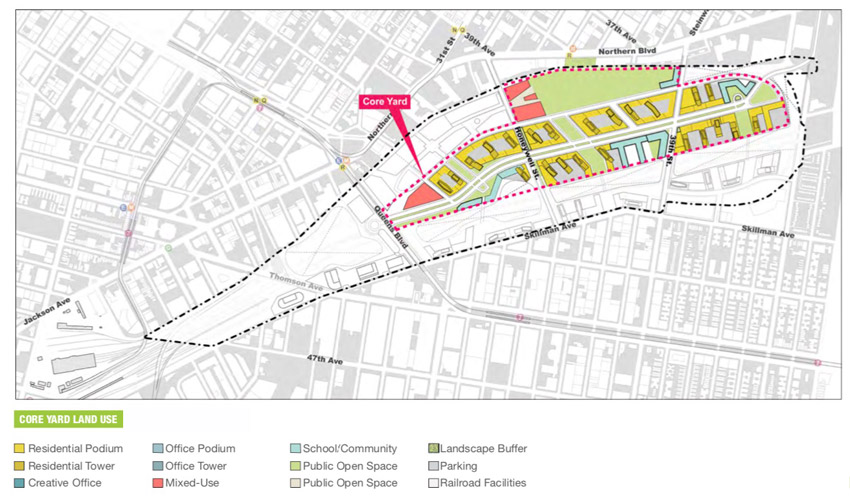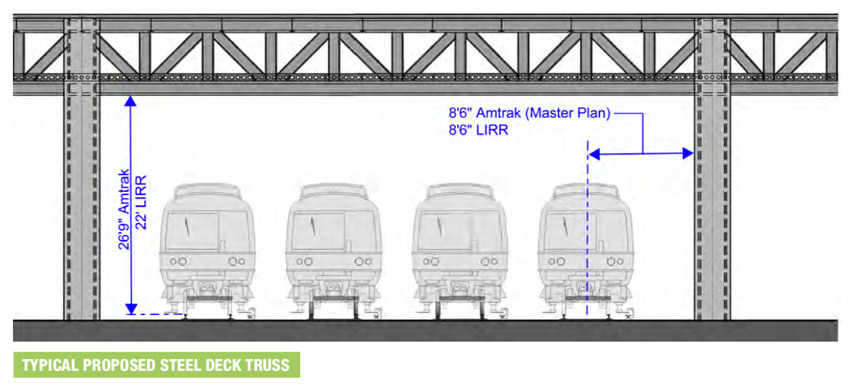Gaining Urban Space: Platforms Over Rail Yards
Land-strapped cities are starting to erect massive steel overbuilds on top of rail yards to spur much-needed urban development
![]() Continuing Education
Continuing Education
Use the following learning objectives to focus your study while reading this month’s Continuing Education article.
Learning Objectives - After reading this article, you will be able to:
- List the factors driving urban interest in developing new real estate on top of platforms covering rail yards and transportation corridors.
- Identify the numerous reasons that make structural steel the material of choice for building these platforms.
- Gather design and installation details about the columns, girders, trusses, and mega-transfer trusses that support the platforms.
- Review various details surrounding New York’s current Hudson Yards project and the Sunnyside Yard Feasibility Study.
- Discuss the complexities and high level of coordination required by these unique projects.
As urban populations continue to surge, space-starved cities are seeking creative solutions to continue developing the commercial, institutional, and residential buildings vital to these metropolitan centers.
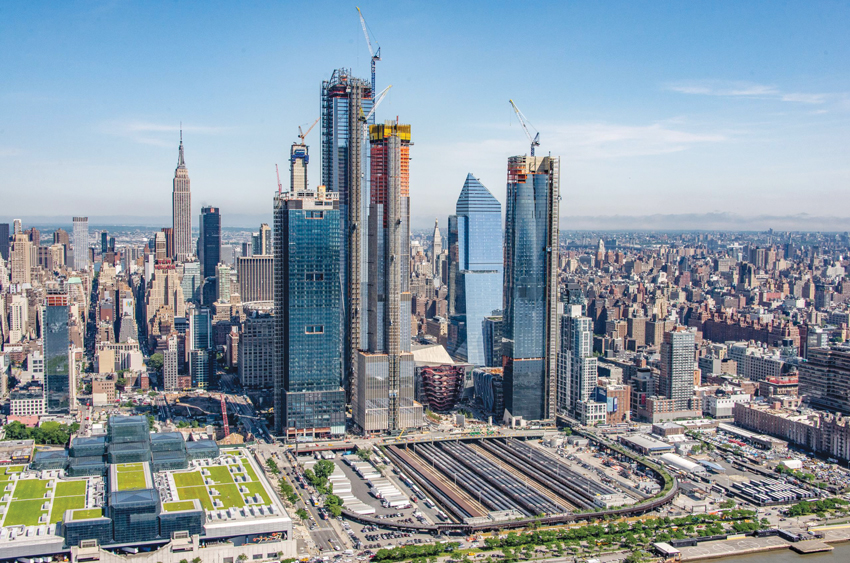
Photo courtesy of Hudson Yards New York/Related Oxford
By creating large platforms over rail yards, urban locales are now tapping into new spaces for building, as pictured here at Manhattan’s Hudson Yards.
To meet this growing need, technological advancements and economic feasibility are merging to support the amazing notion of constructing huge platforms over cities’ rail yards and transportation corridors. These several-acre platforms can then anchor new development in city centers.
A number of cities are already capitalizing on these ideally located air spaces—on the heels of New York’s Hudson Yards development, Philadelphia’s Schuykill Yards, Paris’ Rive Gauche, and several more sites have serious proposals and feasibility studies in the works.
“While developing platforms and infrastructure over active rail yards requires significant engineering and investment, it is a way to develop land in dense urban areas,” explains Eli Gottlieb, managing principal, Thornton Tomasetti, New York. “This can have multiple advantages, knitting back urban fabric that is currently cut by the transit infrastructure as well as capturing large footprints that may not be available on other sites.”
In a similar vein, Juan Estevez, vice president, AECOM Tishman, New York, says, “A great advantage of developing these large areas that have sat silently in what are now densely populated, prime locations is that it allows designers to create a space that is boundless from the usual urban constraints; to create a new city within a city.”
Consider New York City, for example. According to Chris Jones, senior vice president and chief planner for New York’s Regional Plan Association, urban revival has greatly increased the value of well-positioned property—particularly near transit hubs and where rail yards tend to be located—that can be converted to high-density, mixed-use development. “This mismatch of supply and demand is making it profitable to develop even costly and complicated projects.”
While New York’s rail yards were originally built at the city’s edges, there is now a large population living around the tracks, as is the case in many urban areas. As a result, real estate values are high enough to justify the expense of decking over, explains Jack Robbins, AIA, LEED AP, partner, director of urban design, FXCollaborative, New York.
With extremely limited undeveloped site locations, these railroad yards represent large parcels of untapped land.
Steel Anchors Platforms
To technologically enable these mega platforms, experts name structural steel as the material of choice due to its relatively lightweight, high-strength, large-spanning abilities and availability.
“The driving force for material selection for building around active tracks is to maximize the load capacity of the structure while minimizing disruption to the railroad,” explains Estevez. “Steel is certainly a stronger material and has the advantage of reducing the area taken up between tracks to support high-rise buildings above. Steel further has the advantage of the pieces being customizable offsite for a perfect fit that can be set quickly and minimize disruptions.”
A prime example is Hudson Yards, which will ultimately house more than 17 million square feet of commercial and residential space, a public school, and a luxury hotel on top of 30 active Long Island Rail Road train tracks, three Amtrak subsurface rail tunnels, and fourth Gateway tunnel. Here, steel columns were the only solution to meet the hefty column loads—as high as 51,000 kips service—that had to come down between the tracks with only 24 inches of width for clearance.
“By using 65 ksi steel plates laminated to form the full columns, the loads could be efficiently carried in the limited dimensions,” Gottlieb says. Furthermore, “spans range from 35 feet up to 155 feet with the large variety in spans and the grids that shift to the curve of the tracks and switches. Steel was a key material to provide this flexibility.”
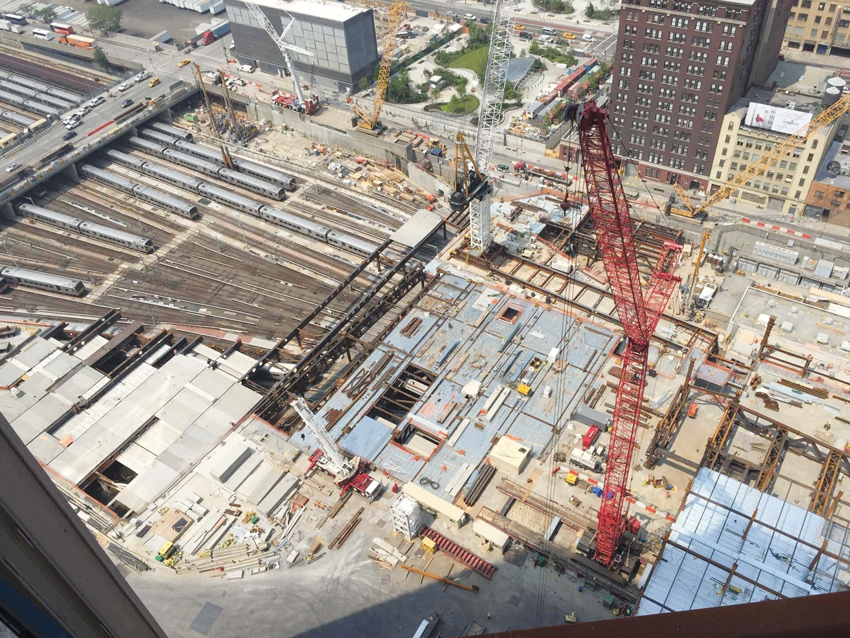
Photo courtesy of Hudson Yards New York/George Butler
This aerial shot of Hudson Yards shows the massive platforms being constructed on top of Manhattan’s active rail yards.
While the concept of decking over has been around for a long time, technology is now making it a reality. For the Hudson Yards project, laminated steel columns were fabricated from layers of high-strength steel made from special steel plates manufactured in Europe.
And advances in construction technique (e.g., use of heavy crane equipment, special gantries, etc.) make erection of heavy and long structural members both possible and economical on the project, according to Yefim A. Gurevich, senior vice president, building structures, WSP, New York.
High-strength steels, such as A913 and A992 65 ksi material, were used for the columns and beams at Hudson Yards. This enabled a significant reduction in material use and more critically, a reduction in the pick weights for the cranes that allowed the project team to fabricate and set larger elements at larger reaches. “This maximized the ability to cover the yard quickly by reducing crane picks and reducing pick complexity,” Gottlieb says.
Robbins points out that today’s structural modeling programs make these designs much more efficient, particularly when dealing with irregular column grids and/or modeling with a time dimension, whether it’s looking at train traffic, pedestrian movement, or vehicular traffic.
Similarly, advanced BIM tools support a greater level of detail and coordination. “This also allows for tighter designs fitting all the required parts together as well as faster construction, as everyone knows how every piece will fit together from structure to MEP to final architectural elements,” Gottlieb says.
Meanwhile, Estevez praises BIM for its ability to clearly show how every trade and system interacts with the one another. “For New York City, our greatest cost is in field labor, so everything we can do to make that work on-site as safe and efficient as possible is a savings to the project,” he says.
Furthermore, with platform projects, decreasing or eliminating disruptions to the railroad is of utmost importance. “Preplanning and microplanning of activities associated with rail outage times in BIM provides crystal clarity to all parties and greatly decreases risk,” he adds.
The Structural Details
There are many complex details that go into designing and installing these massive platforms; the process begins with large caissons that are drilled into the ground.
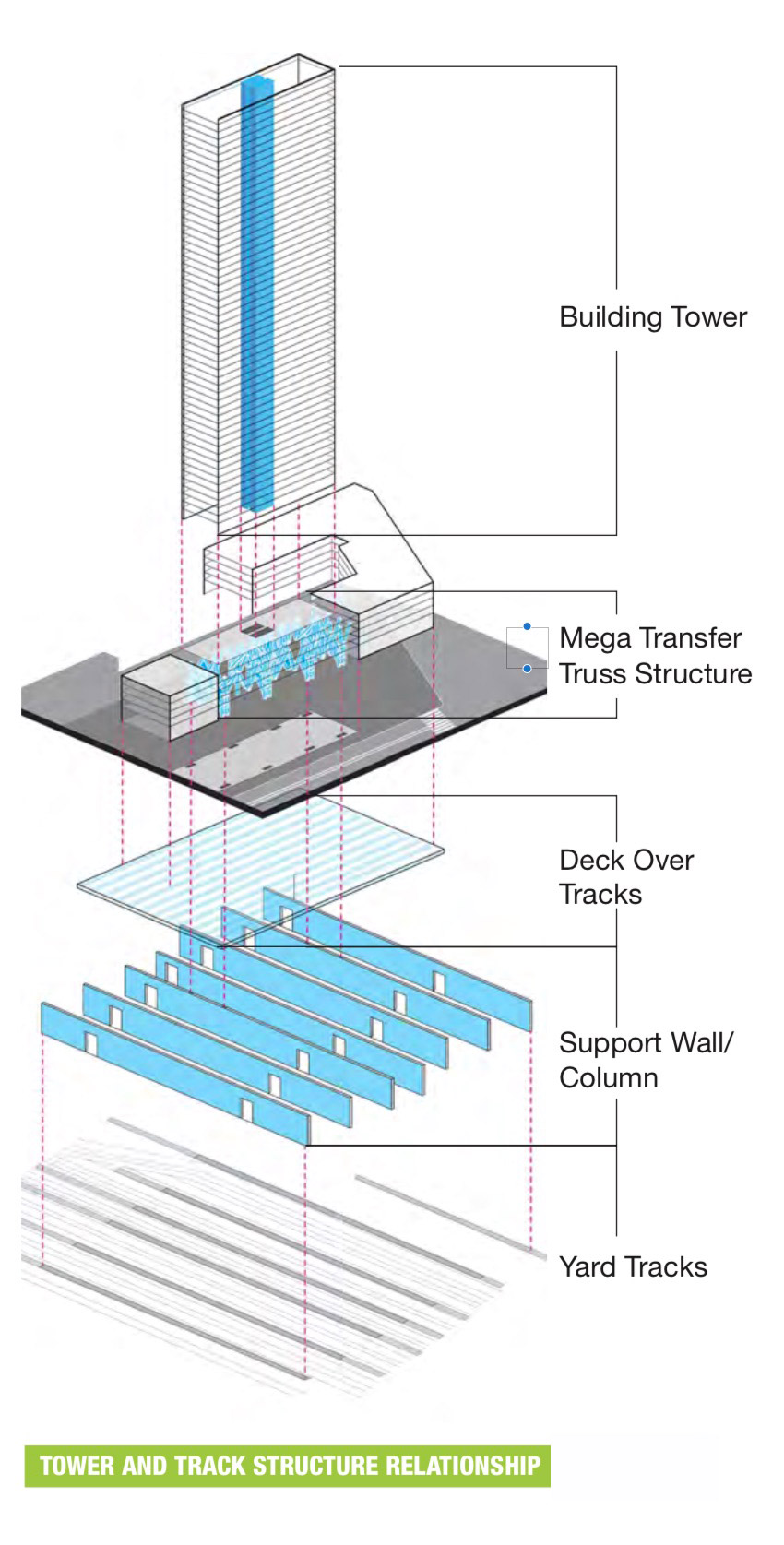
Image courtesy of Sunnyside Yard Feasibility Study
A typical overbuild incorporates support walls/columns, a deck over the tracks, and a mega-transfer truss structure for buildings taller than five stories.
“While foundation selection is highly dependent on soil and rock conditions, large-diameter caissons with structural steel shafts inside will take up minimal space and provide enormous capacity for vertical loading,” Estevez explains.
When working within the confines of a rail yard, those foundations become limited by the available space between tracks to drill in those caissons. Similarly, the diameter of the foundation shafts is limited by the clearance between the rail tracks.
For Hudson Yards, “we used a 60-inch-diameter steel casing on the shafts,” Flynn says. “We placed a solid laminated steel core inside the casing and concrete between the casing and core.”
Each caissons’ capacity was maximized to limit the number of foundations that had to be installed. In some cases, 65 ksi steel cores, as previously mentioned, and built-up plate were used to support individual loads of as much as 25,000 kips service, according to Gottlieb.
Another issue was navigating between the rail utilities and other obstacles that came to the surface as construction progressed. For example, the team insisted that the site be pre-excavated in order to minimize surprises.
The project’s utility-relocation budget alone is estimated at $12 million. This includes altered structural designs for the frame of the platform to accommodate a new caisson location in order to avoid conflicts. In all, a total of 288 caissons, ranging from 4 to 5 feet in diameter and 20 to 80 feet in depth, support Hudson Yard’s Eastern Platform and structures overhead.
Columns, Trusses, and Girders
It’s important to note that a typical 4-inch, A572 plate produced in the United States has a yield strength of 50 ksi. So in order to deliver the required 65 ksi yield strength with a 4-inch plate, a large European steel plate manufacturer was tapped to leverage a fabrication process to produce the laminated plates.
The column structures vary in diameter from 1 foot to 5 feet 6 inches and are drilled into the bedrock beneath the railroad tracks at an average depth of 40 feet below the surface. Approximately 3,300 tons of solid steel cores, the largest of which was 30 by 30 inches, were fabricated from the 4-inch-thick plate. The longest is 87 feet, and the heaviest weighs an amazing 71 tons.
When placed between the tracks, the columns often have size limitations imposed by the “train dynamic envelope,” which is the clearance required for unobstructed train movement, explains Patrick Chan, senior vice president, building structures, WSP, New York.

Photo courtesy of Hudson Yards New York/Geoff Butler
Shown is column, truss, and girder construction at Hudson Yards.
“Moreover, even the shape of the columns is sometimes dictated by this clearance where the tracks are not straight but curved,” he adds. “The fact that these columns often are tall and slender—usually there is no room for any type of bracing inside the yards—also adds to limitations imposed on column design.”
Ultimately, the goal is to lay out the columns to fit the track alignments while creating as uniform a grid in one direction as possible to allow for the standardization of many of the deck elements, explains Gottlieb.
To illustrate the structural and spatial dynamics of the platform, Robbins explains that much of the support is actually created by walls, as opposed to the individual columns.
“What you essentially end up doing is creating walls in between the tracks which act as a kind of continuous column to support the deck,” he says. “Because those structural elements run parallel to the tracks, it means that you have very good structural support in one direction, and it tends to dictate the orientation of the building.”
As a result, the buildings on top of the platform end up running perpendicular to the tracks so that they get the most support.
Spanning in between the columns are steel plate girders and steel trusses. For Hudson Yards, steel plate girders support the plaza area and vary from 35-foot spans up to 120-foot spans, with depth ranging from 4 feet to 6 feet.

Photo courtesy of Hudson Yards New York/Geoff Butler
Shown is the truss for Hudson Yard’s retail structure under construction.
“These girders also are designed to incorporate the mechanical plenums for smoke and air ventilation of the yards as well as incorporate all the other MEP services within their depth,” Gottlieb says. “By providing regular openings, similar to castellated beams, the girders were an ideal way to stack all the structural and mechanical systems together and minimize the depth of the entire system sandwich.”
The plate girders were also used where vertical space was limited and were coordinated in dimension to incorporate all the platform ventilation systems, including fan rooms and ducting, while minimizing the vertical dimension from rail clearance to the top of the finish grade, he adds.
Generally speaking, trusses and beams need to be shallow enough to provide the vertical clearances required by railroad authorities, and the roof over the yards should meet street-grade requirements. In many cases, this can be challenging, as rail yards built at the turn of 19th century are relatively shallow. Using steel helps address this shallow depth issue, in addition to meeting lightweight, long-span, and high-capacity construction needs.
At Hudson Yards, the platform’s base structure clears the tracks by at least 17 feet and ranges in thickness from less than 3 feet to up to 7 feet where special features have been incorporated into the design. For instance, in many areas, the platform houses a network of tubing carrying cooling liquids that will buffer the plaza’s landscaping from the heat of the train yard below, which can reach up to 150 degrees Fahrenheit.
Mega-Transfer Truss
Trusses were used for the largest spans and where there is a lack of interior/intermediate support for overbuild construction.
“A prime example of this type of condition is closely spaced tracks within the yard that do not allow for column placement between them,” explains Jeffrey Smilow, F.ASCE, executive vice president and director of building structures, WSP, New York.
In the case of Hudson Yards, four tracks on the east side branch out into 30 tracks on the west side, and within this track configuration, switches are used to navigate trains in between the tracks. Because the railroad couldn’t tolerate any disruption to the switches, the structural engineers had to span these long spaces between the foundations with large trusses.
The trusses were also coordinated to be the “basement” of the retail building and incorporate services, mechanical rooms, and storage as well as the loading docks for the project.
One advantage with these trusses is that the absence of support columns minimizes construction and time and coordination inside the rail yard. However, this lack of intermediate supports increases the depth of the truss. So ultimately, the fabrication, transportation, and installation is more complex and costly compared to a simple beam/girder system.
As noted, when building these platforms, there’s a misconception that the deck is like a skirt around the building, with a rail yard going through the building basement. In reality, the skirt around the building acts like an extremely large basement, which is the rail yard, explains Robbins.
“You’re trying to figure out how to land the building, and the structural load, to the ground, to terra firma, and the transfer truss ends up being the most efficient way to do that,” he says.
Essentially, the structural engineers are dealing with a set of support points coming up from the foundation and the building coming down on top of that. “You’ve got to figure out how to marry the structure loads coming down and support them, and the transfer truss is what accomplishes this,” Robbins adds.
To do this in the most economical way, engineers try to minimize the span between those touchdown points. Alternatively, if the spans get too large, the design will not be economically feasible.
That said, for Hudson Yards, there are points below the 10-story retail complex where trusses had to span lengths are long as 155 feet and support uniform loads of nearly 4,500 pst. “The trusses required close architectural mechanical and structural coordination to maximize the structure, achieve a usable space, and fit the required systems into them,” Gottlieb explains.

Image courtesy of Sunnyside Yard Feasibility Study
Truss depth increases in relation to the height of the buildings.
While these mega-trusses do solve the challenge of dealing with large spans, it should be noted that their diagonal structural members need to cut through the building core, which makes the space in the podium of the building a little less useable. For example, within Hudson Yard’s retail complex, the truss is installed between floors one and three, and it does take up a portion of the real estate.
Sharing some more details about the truss design, these elements were sized based on erection weight and crane capacity, and many were designed as two side-by-side trusses, which were tied together after erection. “Had a single truss been used, it would have been too heavy to lift over the railroad tracks,” Flynn says. “By splitting the trusses, we could erect one truss at a time and tie them together later. This minimized the impacts to the railroad below.”
The stable box truss assembly formed by these double trusses supported a fast, lightweight installation of precast planks to cover the tracks.
“The trusses were each installed during a 2-hour window once a week in the afternoon over the tracks, allowing all the trusses to be installed in a six-week period, covering half the yard and all the complex switching tracks,” Gottlieb says.
As noted, the structure had to be fully optimized so that all the structural elements could be fitted to the architectural design and the limited dimensional volumes but without using any additional material that would drive up pick weights for the cranes. “Minimizing weight was critical to allow the cranes to efficiently erect the project and minimize crane positions for the project,” Gottlieb adds.
Complex Coordination
While a sophisticated level of engineering and architectural design goes into these platform projects, one of the most challenging aspects is the extremely high level of coordination required. Projects of this nature are highly interdisciplinary; transit companies, engineers, architects, cost estimators, financial modelers, urban designers, and municipal officials must all work together.
“These projects cannot be built efficiently without full dedication and collaboration of the private and public entities involved,” Estevez says.
As opposed to a greenfield project, the notion of coordinating construction with ongoing train operations, yard underground activities, security, ventilation, etc. is a daunting task. “To tackle these challenges [for Hudson Yards], our structural engineering team worked closely with around 20 different consultants representing various engineering fields as well as contractors and clients,” says Silvian Marcus, F.ASCE, director of building structures, WSP, New York. “To add to this mix, every step of design had to pass a rigorous review by city authorities, railroad authorities, police and fire departments, etc.”
Just the issue of taking trains out of commission during construction alone is a difficult and costly endeavor. For example, at Hudson Yards, in areas where the train tracks were straight, the team could take four adjacent tracks out of service at a time, allowing drills and other equipment could be left in place. However, in some areas with switches where trains change tracks, the team was permitted to drill a caisson for only 2 hours each night.
Similarly, the erection and stabilization of steel members could often only proceed within in limited time frames. “These time windows ranged from 20 to 90 minutes, depending on the number and location of tracks affected,” reports Flynn.
Furthermore, the cranes had to be located in “off-track areas,” which increased the distance from the crane to the final location of the piece being erected and made the use of very large cranes necessary.
“We used the largest cranes that were available and then needed to configure the steel members so their weight was within the crane capacity,” he explains. “This led to the side-by-side steel truss concept and also the location of field splices in the laminated steel columns.”
Another challenging issue with these platform projects is the fact that developers are working with a transit company whose primary job is to make the trains run. “They’re not developers, they’re not urban planners,” Robbins explains. “There can be some individuals within the organization who have the vision to see that if you do an overbuild, it can help fund rail operations, but it’s not how these transit companies are used to thinking or doing business, so that’s a paradigm shift for them.”
Project Process
In terms of how to best execute these complex projects, Flynn explains that the first step is addressing the big picture, discussing project needs, and evaluating the ability of the railroad to tolerate some disruption and maintain the necessary level of service.
Before starting the design, the team must collect as much existing information about the existing underground facilities as possible.
If information is limited or unavailable, then an attempt is made to conduct a survey. This survey can be visual for above-ground utilities, or it may use ground-penetrating radar or X-ray techniques for underground utilities.
At Hudson Yards, a detailed 3-D BIM model was developed following a comprehensive study of all existing conditions. The model then served as part of the preliminary design, also helping the project team to determine what items needed to be field-verified.
“The schematics need to be presented early to the operations division of the public entities to assure that the work is feasible and the best solution for the project,” Estevez says. “Subsequent design development and construction documentation needs to be created with collaboration from all entities.”
The building team must also develop a detailed understanding of train operations, as working with preexisting conditions and active train lines is a delicate balancing act. For example, the team could be dealing with an underground foundation and column directly above it.
“Often, due to tight track layout and multiple underground conduits and utilities, individual footings literally have to be carved out to allow for passage of these conduits,” Gurevich explains. “Columns above sometimes must be shaped to accommodate curved train clearance outline and other limitations.”
In terms of ensuring access during these tight time windows, close coordination with the railroad staff is essential. To best enable this, Flynn recommends bringing more railroad personnel into the building team’s project meetings, as these sessions progress from ideas to details.
“It is important for all parties to understand each other’s goals and concerns,” Gottlieb adds. “By having regular interface with the rail design teams, Hudson Yards was tailored to address their concerns, including vertical and horizontal clearance to track outages to meet the rail infrastructure’s needs while allowing the project to be completed.”
Ultimately, the only way to make these complex projects work is with a high level of planning and frequent meetings. “The key is constant communication between the builder and the railroad,” agrees Flynn.
Emphasizing how complex these types of projects can become, Estevez shares a poignant example. At the base of the 30 Hudson Yards 102-story tower, the only place to locate the building core was on a small terra firma area within the northern portion of the site. “The entire building core—including structural lateral load system, elevators, and mechanical systems—had to shift over 80 feet midway up the building to provide full perimeter of window space at commercial floors,” he says.
At 100,000 tons of steel, these issues contributed to making 30 Hudson Yards the heaviest and most complex steel high-rise building ever built.
Code Compliance
Another key issue with platform projects is determining which codes and standards apply, which is not so straightforward.
For example, Robbins asks, “If you build a deck over a railyard, does that make the deck a building, so then the building codes apply? Or if there’s a building that goes through that deck and anchors into the ground, how much of the deck around the building is counted as part of the building?”
This is a grey area with a lot of ambiguity and needs to be carefully evaluated on a project-by-project basis.
Take Hudson Yards. Here, the trains are an Metropolitan Transportation Authority facility that is governed by the New York State Code, in addition to other rail codes set by the Federal Railway Agency. However, the buildings on the site are all governed by the New York City Building Code.
“While the codes are similar and have similar performance goals, there are differences and all parties need to be aligned to avoid conflicts between codes and requirements for the projects,” Gottlieb says. “Making sure that everyone is aligned on which codes the project is following and the critical overlaps is important to the success of the project.”
The sheer number of regulatory documents involved shows the extent to which codes impact design requirements. Ultimately, the platform must satisfy all applicable codes, regulations, and requirements that include, among other things, building, transportation, railroad codes, fire, smoke exhaust, security/blast, and train impact regulations. “Sizes of structural members, their location within the yards, and sometimes even their shape are all affected,” Chan says.
In addition to the issue of codes, these overbuild projects must address a few unique design requirements. For instance, the platforms need to account for heat buildup from the trains. In order to address this for Hudson Yards, an extensive CFD analysis was conducted, and passive air intakes were located and designed to allow the heat buildup to stay within acceptable limits. The heat is then dissipated through this ventilation; three fan plants exhaust the air while three plants provide fresh air to the facility.
The decks are open on the sides, providing some fresh air, “but you still need the supersized fans hung on the ceiling of the deck to help move the air around and provide the ventilation,” Robbins adds.
Maximum and average temperatures of the structural elements were also derived from the CFD analysis, which, in turn, impacted the structure’s fire protection design, Smilow adds.
Another unique issue is emergency egress. In the planning and design, the building team must ensure there are multiple ways that people can exit from under the deck to the surface.
Designers must address the issue of stormwater retention. For another project where FXCollaborative performed a feasibility study, the rail yards’ locale required the proposed project to conform to stricter stormwater standards. Consequently, the design had to incorporate stormwater retention tanks. Such tanks tend to be fairly large and can encompass a significant part of the infrastructure.
The Future of Platforms
With urban population growth not anticipated to slow down any time soon, urban planners and designers anticipate that platform building over rail yards and transportation corridors will really take hold.
In fact, Estevez sees a new set of factors converging. City and state agencies have realized the value of leasing the air space above their properties to private developers; railyards are being sought as a way to renew cities and turn a profit; and the initial investments, risks, and logistics of these projects are starting to make financial sense.
“I think this is going to very much be a growing area,” agrees Robbins.
While these initial overbuilds will struggle with this new way of developing real estate, like any new venture, the more it’s done, the more efficient it will become, and the less costly it will be.
“These current projects are building a knowledge base, so it will become a little easier and more feasible for future projects,” Robbins says. “My hope is that it changes the way some of the transit companies who own large amounts of real state start to think about their real estate and the integration of development and infrastructure.”

